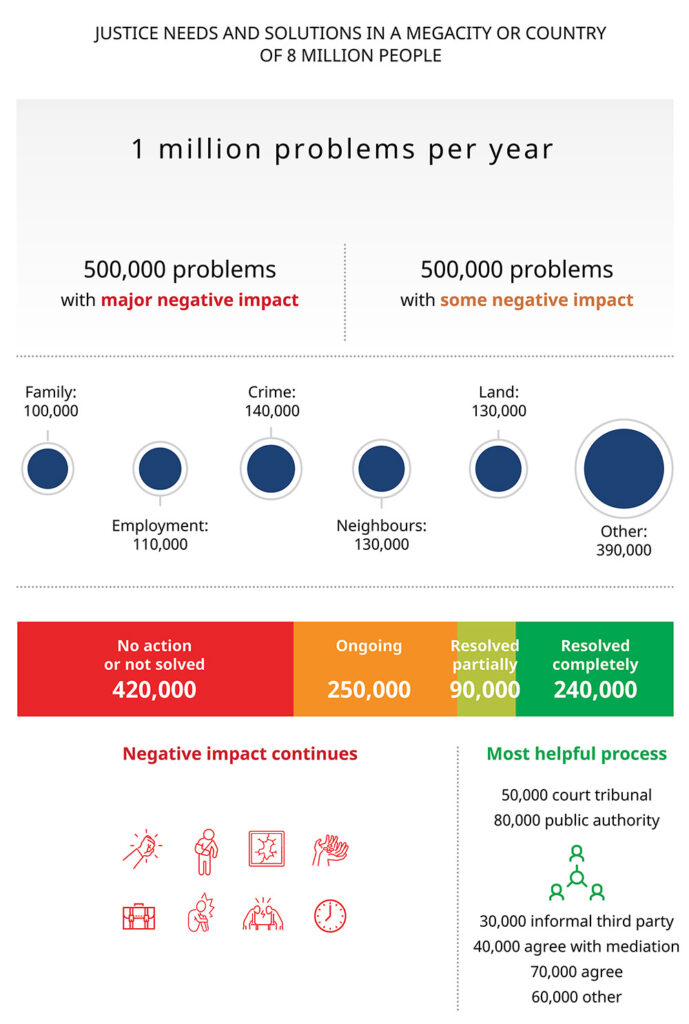Asimow, M. (2015). Five Models of Administrative Adjudication. American Journal of Comparative Law, 63(1), pp.3-31.
Bernstein, Anya and Rodriguez, Cristina. (2022). The Accountable Bureaucrat (March 26, 2022). Yale Law Journal, Vol. 132.
Carlsmith, K. M., Darley, J. M., & Robinson, P. H. (2002). Why do we punish? Deterrence and just deserts as motives for punishment. Journal of Personality and Social Psychology, 83(2), 284–299.
CEPEJ, (2020). European judicial systems: CEPEJ evaluation report.
Clara Sabbagh and Manfred Schmitt, (2016). Handbook of Social Justice Theory and Research.
Ecorys.(2021). MKBA innovatieve rechtsvoorzieningen.
European Commission, (n.d.). Justice and the rule of law. URL: https://international-partnerships.ec.europa.eu/policies/peace-and-governance/justice-and-rule-law_en. Accessed on July 27, 2022.
European Commission, (n.d.). Justice and the rule of law. URL:https://international-partnerships.ec.europa.eu/policies/peace-and-governance/justice-and-rule-law_en#best-practices. Accessed on 28th July 2022.
First Step Act. Wikipedia (2022). URL: https://en.wikipedia.org/wiki/First_Step_Act. Accessed on August 8, 2022.
French Republic, (n.d.). What are the houses of justice? URL: https://www.vie-publique.fr/fiches/268688-justice-de-proximite-les-maisons-de-justice-et-du-droit-mjd. Accessed on August 14, 2022.
Government of Argentina, (n.d.). Access to justice centres. URL: https://www.argentina.gob.ar/justicia/afianzar/caj. As accessed on August 14, 2022.
Government of Brazil, (2021). National plan for public security and social defence 2021-2030.
Government of Canada, (2021). International IDEA – Joint statement on democracy. URL: https://www.canada.ca/en/global-affairs/news/2021/12/international-idea—joint-statement-on-democracy.html. Accessed on July 28, 2022.
Hendley, K. (2017). The Unsung Heroes of the Russian Judicial System: The-Justice-of-the- Peace Courts. The Journal of Eurasian Law, Duke University.
Hermann Pünder, (2013). German administrative procedure in a comparative perspective: Observations on the path to a transnational ius commune proceduralis in administrative law. International Journal of Constitutional Law, 11(4), pp.940-961.
HiiL, (2018). Understanding justice needs: The elephant in the courtroom.
HiiL, (2018). Understanding justice needs: The elephant in the courtroom.
HiiL, (2022c). Policy brief: One-stop shop dispute resolution. HiiL.
International Development Law Organization, (2020). Strategic Plan 2021-2024.
International Development Research Council, (2022). Closing the justice gap with research on legal empowerment. URL: https://idrc.ca/en/research-in-action/closing-justice-gap-research-legal-empowerment. Accessed on July 28, 2022.
Justice Action Coalition, (2022). Justice 2023: Pivoting to people-centred justice.
Manuel, M. and Manuel, C., (2021). People-centred justice for all: A route to scaling up access to justice advice and justice in low-income countries.
Moore, L. and Farrow, T. (2019). Investing in Justice: A Literature Review in Support of the Case for Improved Access, Report prepared for the Task Force on Justice, Canadian Forum on Civil Justice. Taskforce on Justice and Canadian Forum on civil justice.
Muller, S. (2020). An emerging ministers of justice movement. Global dashboard- Blog covering international affairs and global risks.
OECD, (2021). OECD Framework and Good Practice Principles for People-Centred Justice.
Open Government Partnership and Republic of Sierra Leone, (2019). Third Action Plan: Sierra Leone Action Plan 2019-2021.
Open Government Partnership, (2019). Justice. URL: https://www.opengovpartnership.org/policy-area/justice/. Accessed on July 28, 2022.
Organisation of American States, (n.d.). OAS Judicial Facilitators: More justice for more people. URL: https://www.oas.org/en/media_center/press_release.asp?sCodigo=E-046/16. Accessed on August 8, 2022.
Pathfinders, (2019). Justice for all: Report of the taskforce on justice.
Republic of Kenya, (n.d.). Strategic plan 2019-2023.
Republic of Uganda, (n.d.). Access to justice strategic plan 2021-2025.
Tata Trusts, (2020). India Justice Report: Ranking states on police, judiciary, prisons and legal aid.
The Canadian Bar Association, (2021). No turning back: CBA task force report on justice issues arising from Covid-19.
The Elders, (n.d.). Access to justice. URL: https://theelders.org/programmes/access-justice. Accessed on July 28, 2022.
UN Habitat, (1999). Innovative and effective approaches to housing.
UN Habitat, (n.d). Land. URL: https://unhabitat.org/topic/land. Accessed on 27 July 2022.
UNDP, (2021). People-centred approaches to rule of law, security and human rights : Secondary impacts of Covid-19.
UNDP, (n.d). Global thematic programme for accelerating access to justice for human development.
UNODC, (2016). Compendium of United Nations standards and norms in crime prevention and criminal justice.
USAID, (2022). USAID rule of law policy: A renewed commitment to justice, rights and security for all.
V-Dem Institute, (2022). Democracy Report 2022: Autocratization Changing Nature? University of Gothenburg.
Weston, M. (2022). The Benefits of Access to Justice for Economies, Societies, and the Social Contract: A Literature Review, 2022. Open Government Partnership and Pathfinders.
World Bank, (n.d.). Projects. URL: https://projects.worldbank.org/en/projects-operations/projects-summary. As accessed on July 27, 2022.
World Justice Project, (2021). 2021 Insights: Highlights and data trends from the WJP Rule of Law Index.
World Justice Project, (n.d.). Atlas of Legal Needs Surveys. URL: https://worldjusticeproject.org/our-work/research-and-data/atlas-legal-needs-surveys. Accessed on 26 May 2022).
World Justice Project (2019). Measuring the justice gap.

